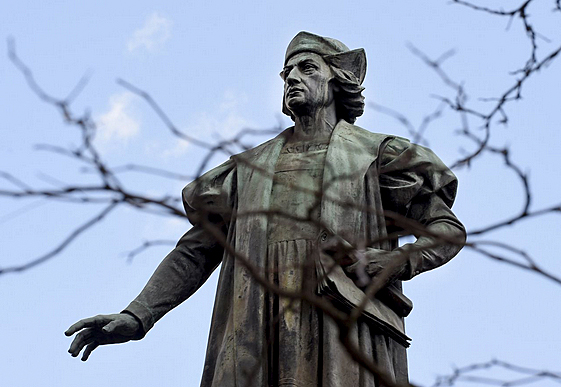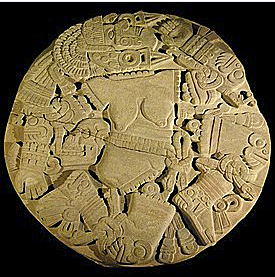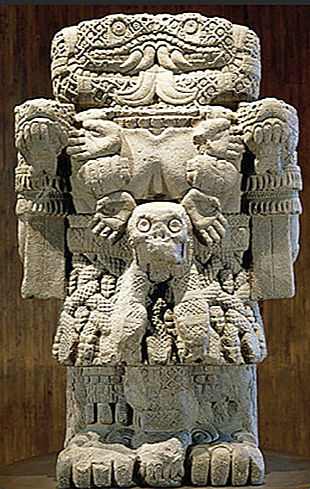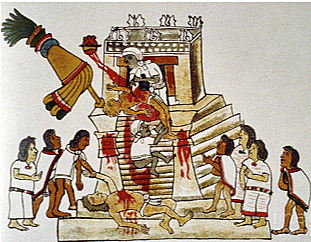
- Articles
Christopher Columbus, Pre-Columbian cultures, and political correctness by Miguel A. Faria, MD
Cliff Kincaid, Director of the AIM Center for Investigative Journalism, wrote an excellent article on GOPUSA.com defending Columbus Day and describing the progressive onslaught not only against Columbus’ discovery of America but also Western civilization. At the end of his article, he asks, “Who will defend Christian civilization and Columbus against this New Age socialist gibberish?” I hope the following narrative draws a series of pictures illustrating what it was really like in the New World before Columbus’ arrival in 1492, and hopefully the illustration of reality, not fantasy, will contribute towards that defense.
Despite progressive vilification, Americans continue to celebrate October 12th as the day Christopher Columbus discovered America.* But since the quincentennial celebration (1992) progressives have been harshly denouncing the event as resulting in deliberate genocide of the peaceful, ecology-minded, indigenous peoples. According to the new conventional wisdom, Christopher Columbus and his discovery of the Americas is an epochal catastrophe that should be scorned and vilified. But what was it like in the New World at the time of Columbus arrival?
The revisionist historians and deconstructionists that are a part of academia, and their allies, the media, have taken pains to denounce this event by exaggerating facts and creating others as they go along to support their revisionist views while neglecting, suppressing or ignoring events which do not.

I would like to elucidate some facts regarding Pre-Columbian history prior to the arrival of the three Spanish carravels, La Nina, La Pinta, and La Santa Maria. With all due respect to Jean-Jacques Rousseau and his “noble savages” concept, which idealizes primitive man uncorrupted by Western civilization, I would like to relate historical accounts which have been thoroughly corroborated by archeological work and anthropological research.
Prior to the arrival of the Europeans, the Arawak Indians (also called Tainos) were the relatively peaceful inhabitants of the Caribbean islands whom we associate with pastoral native scenes. But they were not the only native tribe. In fact, the Tainos were preyed upon and suffered as much from the Carib Indians as at the hands of the conquering Europeans. Throughout the many islands, the peaceful male Arawaks were hunted, killed, and even cannibalized by the ferocious Caribs who ultimately ended up exterminating the peaceful Arawaks from many of the Caribbean islands in the Lesser Antilles. The female Arawaks were taken as wives and slaves by the male Caribs. Atrocities by the Carib Indians were infamous and today these atrocities are often discounted or ignored in the protrayal of the New World as a pristine paradise.
As the fierce Carib warriors invaded northward from the Lesser Antilles to the larger Caribbean Islands in the Greater Antilles, they pillages, looted, plundered and enslaved their weaker neighbors, raiding island after island. It was the sudden arrival of the Spaniards in the New World that stunted their locust-like invasion in the Antilles.
Nevermind all the data we have on the subject, in his book The Conquest of Paradise, Kirkpatrick Sale denied that the Carib Indians “were ferocious or engaged in cannibalism.” He even denies that the Carib Indians inhabited the Caribbean Islands that Columbus discovered (and after which the islands are named). Instead, he counters by citing several obscure instances of mob savagery and cannibalism in Europe during the Middle Ages!

In 1978, subway workers in Mexico City discovered archeological evidence corroborating previous Aztec codices and Spanish accounts relating to the dedication of the twin temples of Huitzilopochtli and Tlaloc, the two supreme Aztec gods of war and rain-water, respectively. A magnificent monolithic disc 10 feet in diameter was also found. It belonged to Coyolxauhqui, the Moon goddess of the Aztec. She was the daughter of the Earth mother goddess Coatlicue and sister of the god of War, Huitzilopochtli. Her brother killed and dismembered her as seen on the Coyolxauhqui Stone. The Aztecs, like their gods, were ferocious warriors. Many years before the arrival of Cortes in Mexico, the Uey Tlatoani or “revered speaker” of the Aztecs, Ahuitzolt, sacrificed 20,000 captured prisoners at the dedication of the twin temples, El Templo Major, to these gods. This ceremony went uninterrupted in the Aztec capital of Tenochtitlan for four days in a spectacular display of blood, gore, and human sacrifices. The need of prisoners for human sacrifices was so great that the Aztes forced their neighbors to fight Flowery Wars for the sole purpose of capturing prisoners both from their enemies and allies for humans sacrifices. Hernan Cortez and his small band of Conquistadores could not have defeated the mighty and savage Aztecs in the years 1519-1521 without the assistance of his staunch allies, the Tlaxcalan indians, who hated the Aztec’s bellicosity and their taste for blood and human sacrifices.

Hundreds of priests participated in this sanguinary affairs, and because of the great number of victims, sacrifices were performed simultaneously, often in rapid succession one victim after another, on top of the dedicated temples. Chests were ripped open with obsidian knives, and hearts torn out of the bleeding chest cavities. Then the hearts were held up for all in the crowd below to see. The hearts were pulsating and gushing blood. The organs were then burned on top of altars named chacmools, while the corpses of the sacrificed victims were allowed to roll down the descending steps of the temples. Blood was allowed to run down the steps and coagulate at the base of the pyramidal structures. The corpses were then dismembered and cannibalized. Blood was also dabbed onto the mouths of stone idols in the temples.**
In other ceremonies, children were drowned or their throats cut for the rain god, Tlaloc, and women were decapitated annually for Coatlicue, the mother goddess. In the sacrificial rituals to Xochipilli (the god of flowers) and Xipe-Totec (the god of youth and spring), the victims were flayed — sometimes while still alive. The victims’ skins were then worn as ghastly garments by the bloodied priests, whose hair were also matted with coagulated blood.
Vassals, allies and subjugated peoples were forced to watch and participate in the grisly ceremonies deliberately to demoralize and terrorize adversaries or potential enemies. In this fashion, using terror as a weapon, they could extract the desired tribute from their weaker neighbors.

Contemporary paintings by the natives themselves, the Codices, supplemented by narratives from indigenous as well as European sources (which were later corroborated by archeological discoveries) provided evidence of these accounts which until fairly recently was suppressed and attributed to the concoction and imagination of the Spanish colonizers, supposedly to justify their misdeeds in the New World.
In other words, European historical accounts, indigenous codices, and even pictorial and archeological evidence had been suppressed or misinterpreted by liberal-minded scholars and politicians because it did not square with their socialist views of indigenous peoples. It took relatively recent by fully incontrovertible and irrefutable archaeological evidence to prove what had been evident and argued by other honest and truth-oriented scholars of Mesoamerican culture for years.

Farther south, the Mayans of Central America have been considered the “Greeks of the New World.” Their civilization arose in the jungles of Mesoamerica to include a territory of independent city-states stretching from southern Mexico (Palenque) and Guatemala (Tikal) to Honduras (Copan) and El Salvador. Yet the fire of this civilization extinguished itself before the arrival of the conquistadors. All present theories point toward a poor relationship among the Mayans themselves and their ecological environment.
The Mayan reversion to a more primitive level of civilization in the jungles of the Yucatan and Central America has been attributed to soil exhaustion from over-cultivation, excessive slash-and-burn agriculture, calamities brought about by plagues, pestilence, overcrowding, poor sanitation, and overpopulation as well as pollution of their environment. Also, entertained as the final cataclysmic event, has been the possibility of rebellion of the masses and annihilation of the planning and ruling theocracy.
Moreover, the Mayans also practiced bloody rites and rituals including human sacrifice, though to a lesser extent than the Aztecs. Even royalty participated in complex bleeding ceremonies of self-mutilation which were definitely not for the squeamish.
For the sake of intellectual honesty and fairness, it should be said that even though it is true that the Europeans did colonize the New World, and by rules of conquest seized land of the defeated natives, decimation of native populations occurred to the greatest extent as a result of natural cataclysmic and unintentional events.
The majority of the casualties in the indigenous population were sustained by disease and pestilence rather than war. It is estimated that between 25 and 50 million indigenous people died during the 300-year period of the conquest. A serious calamity, no doubt, but it must be placed in the proper perspective, and judged by the standards of the age. This depopulation was neither officially sanctioned, anticipated or even intentional by the Spanish or Portuguese authorities. Though much has been said and written about disease brought to the New World by the Europeans such as measles, smallpox, and diphtheria, it should be re-emphasized that these calamities were the result of decreased immunity of the indigenous population to the heretofore unknown European maladies.
These afflictions also had much to do with the mingling of two very different cultures which up to this time had not been in contact with each other than with a deliberate act of genocide. After all, biological warfare, except for a few isolated incidents (i.e., catapulting of plague ridden corpses into besieged cities of the Byzantine Empire) seems to have been for the most part unknown in the 16th century.
In short, all Americans should celebrate Christopher Columbus’ triumph without apologies. The man was not perfect; he was human. And, whether one approves or disapproves, whether one is liberal or conservative, the fact remains that the discovery of the New World represented a spectacular moment in history, and the events it set in motion led to the political documents par excellence in the history of man, the American Declaration of Independence and the United States Constitution with its Bill of Rights, documents immersed in a legacy of enlightened European ideas — justice, equality before the law, individual liberty, free enterprise, social mobility and opportunity, private property, constitutional and limited government — by the consent of the governed.
Today, we are on a perilous path of superficiality and conformity to trends and fashion. Dissension is not permitted without ridicule and ostracism, and after all acceptance of political correctness is easier than standing for unpalatable truths. The assault on Western civilization is intense, and the preservation of our American heritage will depend on the will and resistance of a concerned, vigilant, and well-informed citizenry standing for historic truth.
Footnotes
* Much has been said about that Columbus did not discover America, that the Vikings, Phoenicians, even Chinese seafarers reached America first. For the Vikings, that may have been the case: Erik the Red (c.950-1003), the Norwegian norseman may have even settled in Greenland and explored beyond. But the credit for great explorations and discoveries goes, not to the first man who conceives the idea, or even the one who makes the discovery, but it goes to the one who popularizes the discovery, making an impact on the world. In fact, Stigler’s law of eponymy states that most scientific discoveries are not named after its inventor or original discoverer, but by subsequent men or women who advance the idea or discovery and establishes it as a fact. Regardless of the speculation, Columbus discovered America, and if other seafarers arrived there previously (unlikely), they did not even leave any trace of their discovery and had no impact on civilizationi
** I recommend Mel Gibson’s realistic, well-researched, spectacular, and enthralling epic film, Apocalypto (2006).
References are available upon request.
Written by Dr. Miguel Faria
Miguel A. Faria, Jr., M.D. is Clinical Professor of Surgery (Neurosurgery, ret.) and Adjunct Professor of Medical History (ret.) Mercer University School of Medicine. He is an Associate Editor in Chief and a World Affairs Editor of Surgical Neurology International (SNI), and an Ex-member of the Injury Research Grant Review Committee of the Centers for Disease Control and Prevention (CDC). 2002-05; Former Editor-in-Chief of the Medical Sentinel (1996-2002), Editor Emeritus, the Association of American Physicians and Surgeons (AAPS); Author, Vandals at the Gates of Medicine (1995); Medical Warrior: Fighting Corporate Socialized Medicine (1997); and Cuba in Revolution: Escape From a Lost Paradise (2002).
An older version of this article was published in Campus Report, October 1992 published by Accuracy in Academia (AIA) a branch of Accuracy in the Media (AIM). The text of this article was extracted from Chapter 20, The Age of Exploration and Discovery, in my book Vandals at the Gates of Medicine (1995). It has been republished on October 9-12 yearly since 2015 as a reminder.
This article may be cited as: Faria MA. Christopher Columbus, pre-Columbian cultures, and political correctness. HaciendaPublishing.com, October 12, 2015. Available from: https://haciendapublishing.com/christopher-columbus-pre-columbian-cultures-and-political-correctness-by-miguel-a-faria-md
Copyright ©2015 Miguel A. Faria, Jr., M.D.
1 thought on “Christopher Columbus, Pre-Columbian cultures, and political correctness by Miguel A. Faria, MD”
Maya Train Route in Yucatan, 2023!
To the ancient Maya, the cenotes of the Yucatán Peninsula were sacred as they believed them to be portals to the gods of the underworld. These underground caves are also one of the most unspoilt freshwater ecosystems in Latin America. Their tranquillity contrasts with the recent noise and construction unfolding directly above them. The final columns and tracks are being laid for the Mexican president’s pet infrastructure project: a partially-elevated rail link called the Tren Maya (Maya Train). The network will stretch for 1,500km (930 miles) in a vast arc from Chiapas state to the border with Belize – bringing, its supporters say, tourism and development to the jungle. The Tren Maya has overcome numerous obstacles before its inaugural journey. It cost around $28.5bn (£22.5bn), running an estimated three times over budget. With characteristic bravado, President Andrés Manuel López Obrador, also known as Amlo, has called it “the greatest construction project in the world.” —BBC https://www.bbc.com/news/world-latin-america-67638183
I agree with the environmentalists on this one. There were good roads through the pristine Yucatan jungles without the need of train and habitat destruction. This one is the exact route we took back in 1983 (in a 10 day trip) in one of our many fantastic Meso-American archaeological journeys in Mexico! The train is not needed. It will bring more tourists, yes, but also more crime and more drugs to a peninsula that except for Cancun and the Mexican Riviera (initiated in the lat 1990s), was free of those evils! —Dr. Miguel Faria